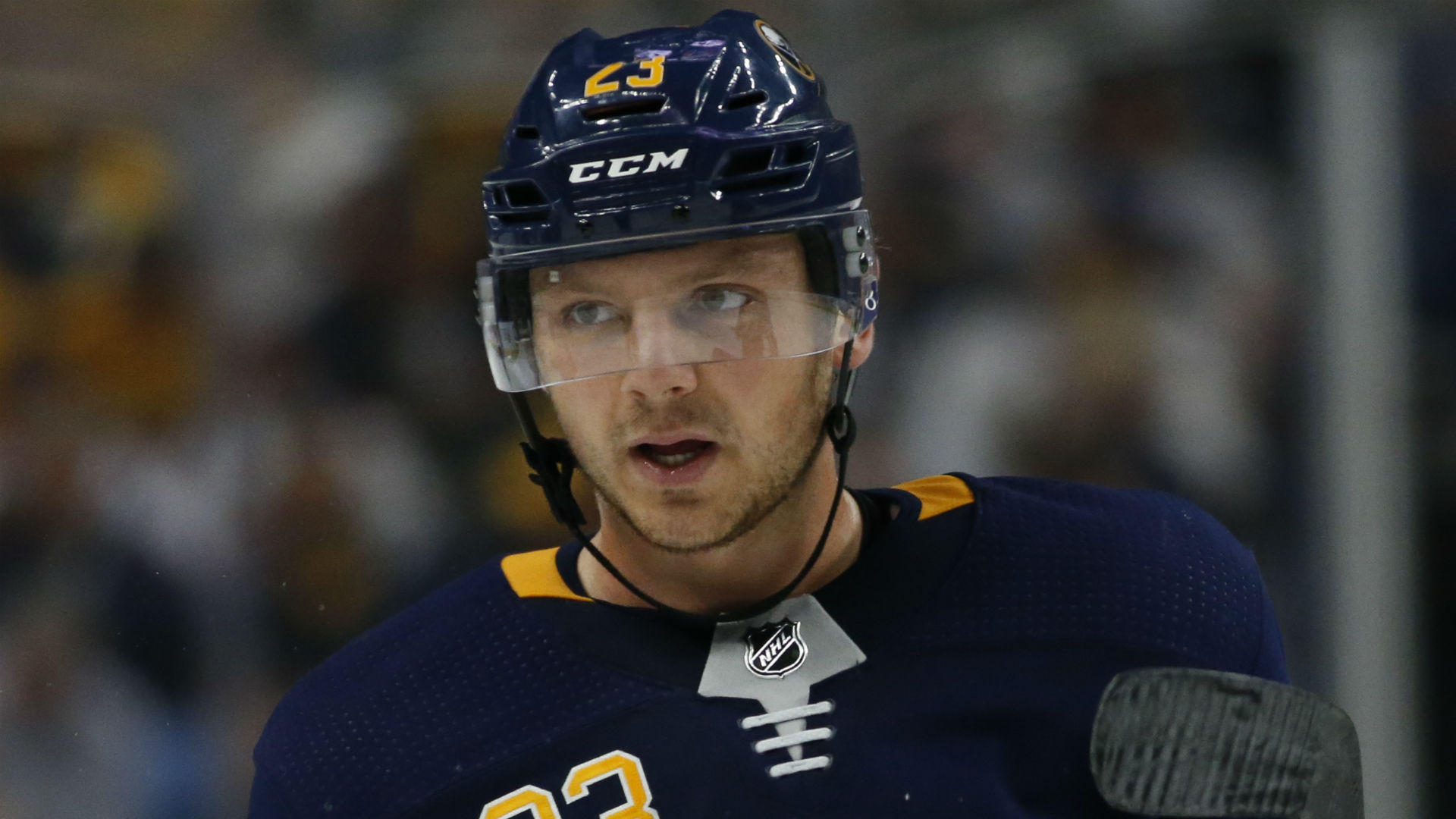Four years ago, the Sabres went through a scorched-earth rebuild that saw them tear their entire organization down to the ground. The result was two seasons of some of the worst hockey the NHL has seen from a non-expansion team in the modern era.
The end goal: Rebuild the organization through the draft with top picks, the ultimate prize being Connor McDavid in 2015. Unfortunately for the Sabres, that part of the plan went sideways when they lost the McDavid lottery and ended up with the No. 2 overall pick in the draft, selecting Jack Eichel. It was not the worst situation in the world as Eichel was still a top-tier prospect and in almost any other year probably would have been a No. 1 overall pick himself.
MORE: Even Jack Eichel's breakout season can't fix broken Sabres
Along with Eichel's arrival, the Sabres stopped selling off of players and started adding veteran talent to the roster. They traded for Evander Kane and Zach Bogosian from the Jets. They picked up Ryan O’Reilly from the Avalanche in what turned out to be an extremely one-sided trade that broke in their favor. They acquired a new starting goalie, Robin Lehner, from the Senators. They hired a Stanley Cup-winning coach in Dan Bylsma to run the team behind the bench. Two years ago, they paid huge money to Kyle Okposo in free agency.
All of that, along with the arrival of Eichel and the presence of Sam Reinhart, another No. 2 overall pick, seemed to indicate better days were on the horizon and that maybe the plan would one day start to work.
It never really happened. After two years of mediocre hockey and no significant progress, the Sabres wiped the slate clean once more by firing Bylsma and general manager Tim, replacing them with Phil Housley and Jason Botterill.
Now, 43 games into the 2017-18 season, the Sabres are not only one of the worst teams in the NHL (their 29 points are the second fewest in the league), but they are playing at nearly the same level they did a few years earlier when they were in tank mode trying to intentionally finish near the bottom of the league.
THE OLYMPIAN: Greenway breaks 98-year USA Hockey color barrier
Through 43 games in 2013-14 (when they finished with only 52 points) they had … 29 points.
Through 43 games in 2015-15 (when they finished with only 54 points) they had … 31 points.
When looking at the NHL this season, the Coyotes, the only team behind the Sabres in the standings, at least have somewhat of an excuse for being so bad. They are one of the youngest teams in the league, have the smallest payroll, have a ton of rookies, and have already used 10 players under the age of 22.
Nobody was really expecting them to be winning a lot by this point.
But this Sabres team? This is a veteran team. The only players on the roster under the age of 24 are Jack Eichel, Sam Reinhart and Rasmus Ristolainen, all of whom have at least three years of experience in the NHL. They have 13 players age 26 or older. This is no longer a rebuilding team. This is a team that was supposed to be winning by this point. A team that was supposed to be back to being a playoff contender.
All of that makes this situation even worse than it seems when looking at the standings. This is probably the best — or at least close to it — that this group has to offer as currently constructed.
MORE: How the 2018 Olympics might've looked with NHL players
How did all of this go so, so, so wrong? Let’s start with some big-picture stuff.
While the Sabres have invested heavily in adding forwards (O’Reilly, Kane, Okposo, bringing back Jason Pominville), they have done a pretty miserable job assembling a defense.
The Sabres are getting next to no offense from their blue line, and there really aren’t many players that are capable of adding it. Their best player, and one of the core players of the rebuild, is Rasmus Ristolainen, a first-round draft pick by the team in 2013 and a fairly polarizing player. On one hand, he is the one player on the blue line that is at least a threat to do something offensively. Ristolainen has had back-to-back 40-point seasons, looks the part of a top-pairing NHL defenseman, and the Sabres most definitely use him like one, playing him more than 26 minutes per night.
The problem is he doesn’t always produce the results of a 26-minute per night, top-pairing defenseman.
Ristolainen has been a terrible possession player (even within the context of his own bad possession team), the team bleeds shot attempts (and goals) against when he is on the ice, and he is probably playing in a role that he is not quite suited for. He is a fine NHL player, and given his skill set could be very useful on a good team. But any team that is relying on him to be its top defenseman and go-to-guy at this point is asking too much.
MORE: The evolution of Auston Matthews
Once you get beyond Ristolainen, the defensive depth chart falls apart.
At forward, the Sabres have three very good top-six forwards in Eichel, Kane and O’Reilly.
Eichel may not be Connor McDavid or Auston Matthews, but he is still close to a point-per-game player and can be a foundational building block, and with his new eight-year contract, he is absolutely going to be just that. O’Reilly is a fierce two-way player and Kane, while probably not the player he was expected to be when he first came into the league, has scored at a 30-goal pace over 82 games since joining the Sabres.
Kane is also an unrestricted free agent after this season and is likely to be traded before the Feb. 28 deadline.
But for as good as that trio is, the depth behind them is almost non-existent. It's led to a team that has been one of the worst offensive hockey clubs in the league for several years now.
GRETZ: How a Drew Doughty-Erik Karlsson free agency would alter the NHL
Part of that is due to a player like Zemgus Girgensons, a first-round pick in 2014, not really panning out.
Reinhart, the No. 2 overall pick the year before Eichel, has badly regressed this season and is barely on a 25-point pace. His production is nearly cut in half from what it was the past two years during a season in which he was supposed to take a big step forward, especially as he plays for a new contract.
Okposo, in Year 2 of a seven-year, $42 million contract, is having a miserable season and is on pace for one of the worst offensive performances of his career.
They tried to recapture some old magic with Pominville, once a fan favorite in Buffalo during better days, but it is clear that he does not have much left in the tank.
When a team embarks on an all-out rebuild, there is never any guarantee that is going to work. The Sabres gutted a bad team, tried to stockpile as many draft picks as possible, tried to put itself in a position where it could get franchise-altering players, and then tried to add veteran pieces.
MORE: Finding legitimacy among playoff contenders at season's midpoint
Other than getting Eichel and a couple of good players in Kane and O’Reilly, almost nothing else has worked. Now, four years after starting that massive rebuild, the team is in no better shape than it was when it all started.
If anything, you could make the argument the franchise is now in worse shape because of the age of the roster, where almost everybody outside of Eichel and Reinhart is past what is expected to be a player’s peak age for production, and the fact they have already wasted the three cheapest years of their best player (Eichel) under the salary cap.
Now they have to try and rebuild — again — around a $10 million per year player, plus the $13.5 million that Okposo and O’Reilly will be making for the next five years as they age into their late 20s and 30s.
It’s one thing to cheer for a bad team when you know it’s part of a long-term strategy to rebuild it into something better in the future. It’s another entirely to have to cheer for a bad team that actually tried to put a winner on the ice.


